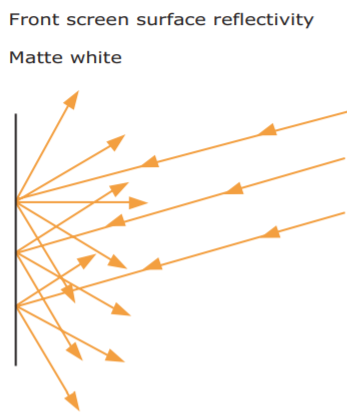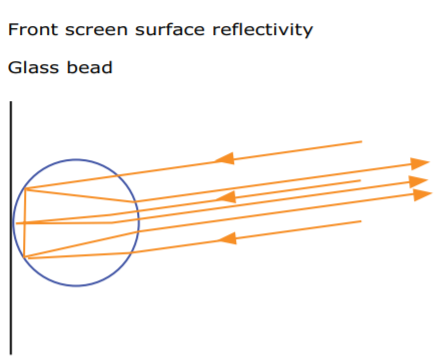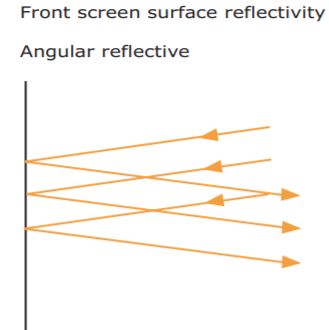Projector Screens
In this blog we will primarily talk about front projection screens, while investing on 4K Projector for Home theatre or for office or for auditorium, projection screen is critical to ensure the quality of projected image. Main purpose of the screen is 1.Get the best quality image 2. direct the light from the image back to the viewer in the most effecient way possible 3. limits to be provided on the image to visually separate the image from the wall.
Two main types of Screens –
- Reflective screen 2. Transmissive screens , since we are discussing about the front projection, we will focus on REFLECTIVE screens, where the light is bounced off of the screen and returned to the viewer
- Transmissive screens – Rear projection screens in which light projected from behind the screen passes through the screen to a viewer in front of the screen
Screen Gain
Increasing the surface of the screen to increase the reflected light to increase/multiply projector brightness is screen gain. Ability of the screen to redirect the projected light to make the image appear brighter within the viewer axis.
The higher the gain number of a screen, the brighter the picture viewed on the axis.
A screen should provide uniform brightness over the entire image area with no dim areas or hot spots, This is referred to as UNITY GAIN screen, mean if it disperses reflected light evenly and equally in a spherical pattern of 180 degrees within the same brightness.
Ambient reflected light rejection generally increases as the gain of the screen increases, light becomes more directional as the screen gain increases. Reflected ambient light then appears outside the viewing cone.
Screen Hot-spotting
As the gain increases so does the hot spotting, brightest area in the screen is the hot spot
screen manufacturer develop surfaces to yield high gain with minimal hot spotting. Hot spotting is one of the tradeoffs for screen gain in front projection screens and is most noticeable when viewing the projected image off-axis
Projection System Brightness
Brighter the projection system, the more it can stand up to ambient light.Lumens is display brightness specification, a Lumen is an average brightness rating, this does not take into account the screen type or the type of image to be projected
Peak brightness is a measurement of the maximum light output of the display without regard to the contrast ratio ( the difference between the darkest and lightest areas)or resolution if 4k or full hd or lower. The measurement is taken from a small, illuminated, portion of a screen. A white window is projected onto to 10 to 20 percent of the screen. The light level is read in foot candles ( or lux) at screen’s surface. Lumens = SH( Screen height) + SW( Screen width)* AF ( average Foot candles)
The American National Standards Institute ( ANSI) nine zone method is perhaps the most accurate way to measure the display brightness because it averages in even the darkest spots of the screen.
For this measurement following process is followed-
- project light onto a screen and focus it at maximum, aperture
- divide the screen into 9 equal parts
- take an incidental light meter reading in the center of the each area
- add the readings
- Divide the total by nine to get the average foot-candles readings
- use the peak brightness formula to obtain the ANSI lumesn ratings
A front projection screen is a passive reflector of light. Its light reflection can be manipulated to improve brightness by changing the screen’s surface, position, or contour.
Front Projection Surfaces
Front projection screen can be made in variety of surfaces and are usually chosen based on the application-
- Matt white
- Glass beaded
- Lenticular
- Angularly reflective
Matt white – its the most common type of front projection screen, these are usually composed of magnesium carbonate . A matt white screen evenly disperses light 180 degrees both horizontally and vertically, it has smooth non gloss surface similar to white sheet. It provides good color rendition and is considered the best for data and graphic representation

Glass bead screens are covered with tiny glass bead, each of which provide a spherically reflective surface. They reflect light back at the source and are best used if the viewer’s eyes are near the same general level as the projectors, such as when the projector is positioned at desktop level and the viewing audience is seated, screen is recommended for video and large-font computer data only.
Lenticular SCREEN – uses a series of ridges arranged in a geometric pattern that act as fresnal lens, condensing the light and transmitting the light to the viewer with a high level of efficiency, resulting in high level of brightness and contrast
Angular Reflective screen surface provide performance similar to that of a mirror. The light is reflected back at the same angle that it strikes the screen but on the other side of the screen axis.If a projector is mounted at a height equal to the top center of the screen, the viewing cone’s axis would be directed back at the audience in downward direction. Most high gain screens ( with a greater that 5) are of this type, This screen type work well for video




